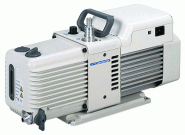3 Types of Vacuum Pumps
Need a vacuum pump? Vacuum pumps can be categorized as:

Cole-Parmer® Rotary Vane Vacuum Pump
- Laboratory/Filtration vacuum pumps: low vacuum pumps used in filtering, drying, degassing, and evaporation applications. Most laboratory/filtration pumps have vacuum and pressure capabilities
- Rough vacuum pumps: used in applications requiring a level of vacuum less than 10–3 Torr, such as degassing, freeze drying, and cryogenics
- High vacuum pumps: those vacuums higher than 10–3Torr, used for mass spectroscopy, electron microscopy, evaporation coating, and space simulation
Additionally, vacuum pumps may be dry, water-based, or oil-lubricated:
Dry Pumps (non-lubricated) offer a clean vacuum over the entire vacuum range. These pumps require little maintenance and don’t generate any waste materials. Dry pumps do have a higher initial cost. Typical dry pumps include diaphragm, piston, scroll, and turbomolecular pumps.
Water-Based Pumps provide a rough vacuum at low initial cost with minimum maintenance.
These pumps are corrosion resistant but are unsuitable for water vapor sensitive systems. Another concern for these pumps is disposing of contaminated water. Common water-based pumps include water aspirator pumps.
Oil-Lubricated Pumps deliver high pumping speeds and a range of ultimate vacuum at an economical price. However, these pumps require routine maintenance and oil changes. The oil may contaminate your vacuum. The pumps also require inlet and outlet filters to protect the pump and the environment. Oil-lubricated pumps include rotary vane pumps and gear pumps.


Comentarios
Publicar un comentario